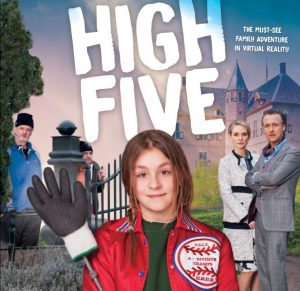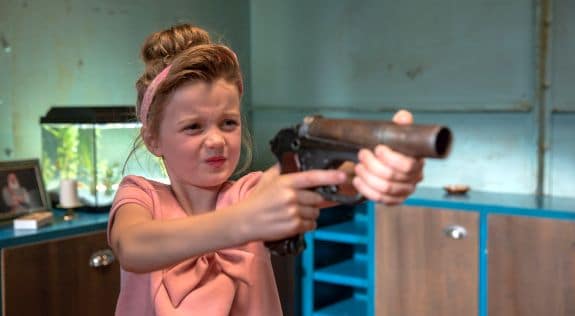‘Alsof je midden tussen de acteurs staat.’ Dat was destijds de slogan waarmee 3D als nieuwtje in de bioscoop werd aangeprezen. In de praktijk bleek daar veel op af te dingen, maar het nu sterk in opkomst zijnde virtual reality (VR) maakt die belofte alsnog waar. Zoals bijvoorbeeld te zien in de VR-film Ashes to Ashes, bekroond met de Dutch VR Award voor beste ‘immersieve’ 360-graden film.
Sinds vorige week is deze korte tragikomedie via de app van AVROTROS, We Share VR and Jaunt VR thuis te bekijken. Twee andere Nederlandse speelfilmexperimenten volgen binnenkort. The Night Watch met een eigen app, waarna in de tweede helft van april High Five in de Amsterdamse VR Cinema in première gaat. Projecten die internationaal aandacht eisen. Lees hier waarom die eigenzinnige Hollanders dat zo goed doen. (tip: breek de regels)
Een stevige puzzel
Drie speelfilms, dat is in de VR-wereld nog tamelijk bijzonder. Sommigen twijfelen er zelfs aan of dit nieuwe medium wel geschikt is voor het vertellen van verhalen. Het scenario van Ashes to Ashes werd geschreven door Anne Barnhoorn (Gouden Kalf voor Aanmodderfakker) en dat was, zoals ze zelf zegt, een stevige puzzel. Toen ze ter voorbereiding een groot aantal VR-producties bekeek had ze al snel in de gaten dat het visueel vaak heel sterk was maar dat een echt verhaal meestal ontbrak. “Terwijl het scenario voor mij juist heel belangrijk is, dus dat leek me een leuke uitdaging.”
Wie zo’n duikbrilachtige VR-kijker opzet wordt als het ware naar een andere wereld geteleporteerd. De film, als je het zo noemen wilt, is overal om je heen. Kijk omhoog of draai je om, overal valt iets te zien. Het kan een experimentele animatie zijn waar je in rondzweeft (DEEP), een trainingssituatie voor mensen met straatvrees, of een Afrikaans dorpje dat zich herstelt van ebola, zoals in de VR-documentaire Waves of Grace. Maar die bijzondere totaalervaring maakt ook dat de traditionele verteltechnieken, waarmee een speelfilmmaker is opgegroeid, in VR grotendeels onbruikbaar zijn. Een close-up bestaat in VR niet, en montage is ook lastig. Het lijkt soms wel of VR en verhaal elkaar bijten, maar daar is toch niet iedereen het mee eens.
Een mix van theater en film

Jip Samhoud, oprichter van &samhoud media en producent van High Five, gelooft dat speelfilm en VR wel degelijk samen kunnen gaan. “Omdat VR een ander medium is moeten we opnieuw uitvinden hoe het werkt. Ik denk wel dat het kan, maar je moet het vergelijken met een mix van theater en film.” Hij is zojuist terug uit de Verenigde Staten en heeft gemerkt dat VR-makers overal tegen dezelfde vragen aanlopen.
Veel werk verkeert nog in het experimentele stadium, maar hij ziet ook dat het belangrijk is om talent aan te trekken. Met goede schrijvers, regisseurs en acteurs komt het al snel op een hoger niveau.
Frank Lammers is bij High Five regisseur en hoofdrolspeler, en ook Daan Schuurmans en Bracha van Doesburg doen mee. Het wordt een korte familiefilm (ongeveer 20 minuten) met veel humor, geïnspireerd op Home Alone, een film waar Jip Samhoud fijne herinneringen aan heeft. Lammers speelt een van de twee boeven die het hier gemunt hebben op de high five-machine van een geniale jonge uitvindster.
Een van de problemen die de makers moesten oplossen is het richten van de aandacht van de kijker tijdens de achtervolgingen door het kasteel. Met geluid kan je veel doen en het werkt ook psychologisch. Als je iemand ziet schrikken volg je automatisch diens blik. De film bestaat wel uit een montage van meerdere scènes op verschillende locaties, maar iedere scène op zich is opgenomen in één take die wel een paar minuten kan duren. Voor de acteurs leunt dat dicht tegen theater aan.
De plaats van de kijker
Een belangrijke vraag bij VR is ook hoe je de kijker een natuurlijk plek geeft. Wordt die betrokken bij de actie, of blijft het meer een toeschouwer. High Five koos voor het laatste.
In de surrealistische tragikomedie Ashes to Ashes staat de kijker in een woonboot tussen ruziënde familieleden die grote moeite hebben met de laatste wens van hun overleden vader. Ook hier is het alsof je bij een theatervoorstelling op het podium tussen de acteurs staat. “Maar het verschil is toch dat je niet echt mee kan doen en ook niets terug kan zeggen. Dat kan storend zijn”, meent Anne Barnhoorn. “Daarom heb ik er voor gezorgd dat je in Ashes to Ashes de plaats inneemt van de urn met de as van de overledene. Het is dus logisch dat je niets terug hoeft te zeggen als je wordt aangesproken.”
Spel met realiteit

Als aanloopje naar de uiteindelijke film van 10 minuten schreef Barnhoorn een openingsscène die vervolgens op de Dutch VR Days van 2015 door drie verschillende regisseurs werd verfilmd. Die drie versies waren voor Barnhoorn heel leerzaam. “Ik had bijvoorbeeld te veel dialoog, en dat werkt niet als de toeschouwer gewoon in het rond kan kijken. Om het verhaal zo visueel mogelijk te maken heb ik onder andere het kussengevecht bedacht. Maar het sturen van de aandacht van de kijker blijft moeilijk. Met geluid kan je veel doen, maar toch is er een kans dat je iets mist omdat je net een andere kant op keek. Als je de film vaker ziet kan je weer nieuwe dingen ontdekken. Het is nog onontgonnen terrein.”
Een van de verrassingen van Ashes to Ashes is dat halverwege plotseling het decor wordt opgehesen zodat we de filmploeg zien. Dat spel met twee niveaus van realiteit zat nog niet in het script van Barnhoorn, maar is door de regisseurs (Ingejan Ligthart Schenk, Steye Hallema, Jamille van Wijngaarden) toegevoegd. Aan de ene kant vindt Barnhoorn dat dit visuele experiment heel knap is uitgevoerd en is ze trots op het totale resultaat. Toch blijft haar eigen prioriteit bij het scenario liggen. Doordat al die visuele vondsten veel aandacht opeisen is het verhaal wat moeilijker te volgen. Dat vindt ze wel jammer.
De regels breken
Een sterk staaltje is dat het de makers van Ashes to Ashes is gelukt om de hele film, op de titelrol na maar inclusief alle ingenieuze decor- en scènewisselingen, in één take op te nemen.

Dat lijkt de stelling te ondersteunen dat je in een VR-film liever niet moet monteren. Juist daarom is het aardig om bij wijze van contrast te zien hoe Maarten Treurniet (De Heineken ontvoering) zich met zijn The Night Watch niets van dat voorschrift aantrekt. In deze spannende korte film met een griezelige twist schrikt een ingedommelde nachtwaker plotseling op en gaat op zoek naar een indringer. Zijn dooltocht door het spookachtige fabriekscomplex is betrekkelijk traditioneel gemonteerd, en dat blijkt uitstekend te kunnen. Als er al een lichte desoriëntatie optreedt dan past dat prima bij het onderwerp.
Treurniet: “Bij de presentatie op de Dutch VR Days waren de meeste reacties enthousiast. Alleen twee VR-deskundigen waren boos omdat ik me zogenaamd niet aan de regels had gehouden en je in de film weinig tijd kreeg om rond te kijken. Maar regels zijn er om te breken.”
Producent Bas Pinkse van 25 FPS Commercial Production ziet The Night Watch als een experiment met het doel de VR-film meer verdieping te geven. “Een film met een kop en een staart. Het was een leuke ontdekkingsreis en een goed gevecht.” Hij stipt ook de meerwaarde van een goede cameraman aan en hoopt dat het eindresultaat zich onderscheidt.
De zaklantaarn
Regisseur Treurniet, die ook het scenario van The Night Watch schreef, meent dat de VR-film net als 3D het stadium van effectbejag moet ontstijgen. “We moeten nog uitvinden hoe die nieuwe beeldtaal werkt. Je kan volgens mij best monteren, maar je moet er bij het snijden wel rekening mee houden dat het aandachtspunt van de kijker niet verspringt. Ik gebruik ook de zaklantaarn van de bewaker om de aandacht van de kijker te richten.”
Wat het natuurlijk meehelpt om het overzichtelijk te maken is dat er in The Night Watch maar één acteur (Guy Clemens) is en dat de kijker niet wordt aangesproken.
Gevraagd naar de toegevoegde waarde die VR biedt noemt Treurniet naast het sterke gevoel echt aanwezig te zijn ook de rol die de locatie speelt. “Die is als het ware een karakter in de film.” The Night Watch is gedraaid bij afvalverwerking Rijnmond.
Welke verhalen zich bij uitstek lenen voor VR durft Treurniet nog niet te zeggen. Maar: “Een drama in een afgesloten ruimte, zoals een vliegtuigkaping, zou zich er goed voor lenen. Ik denk ook aan een film zoals Ocean’s Eleven. We wilden weten of het kon. Nu moeten we doorpakken.”
Ashes to Ashes is te bekijken via de apps van AVROTROS en andere partners van producent Submarine Channel.
De app voor The Night Watch is over enkele weken beschikbaar via Google Play.
High Five wordt rond eind april verwacht in de VR Cinema in Amsterdam, later ook in andere plaatsen.
